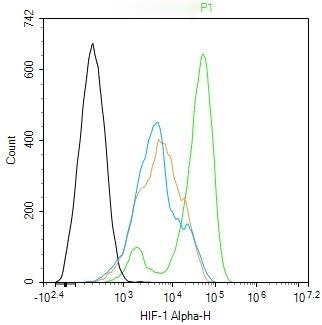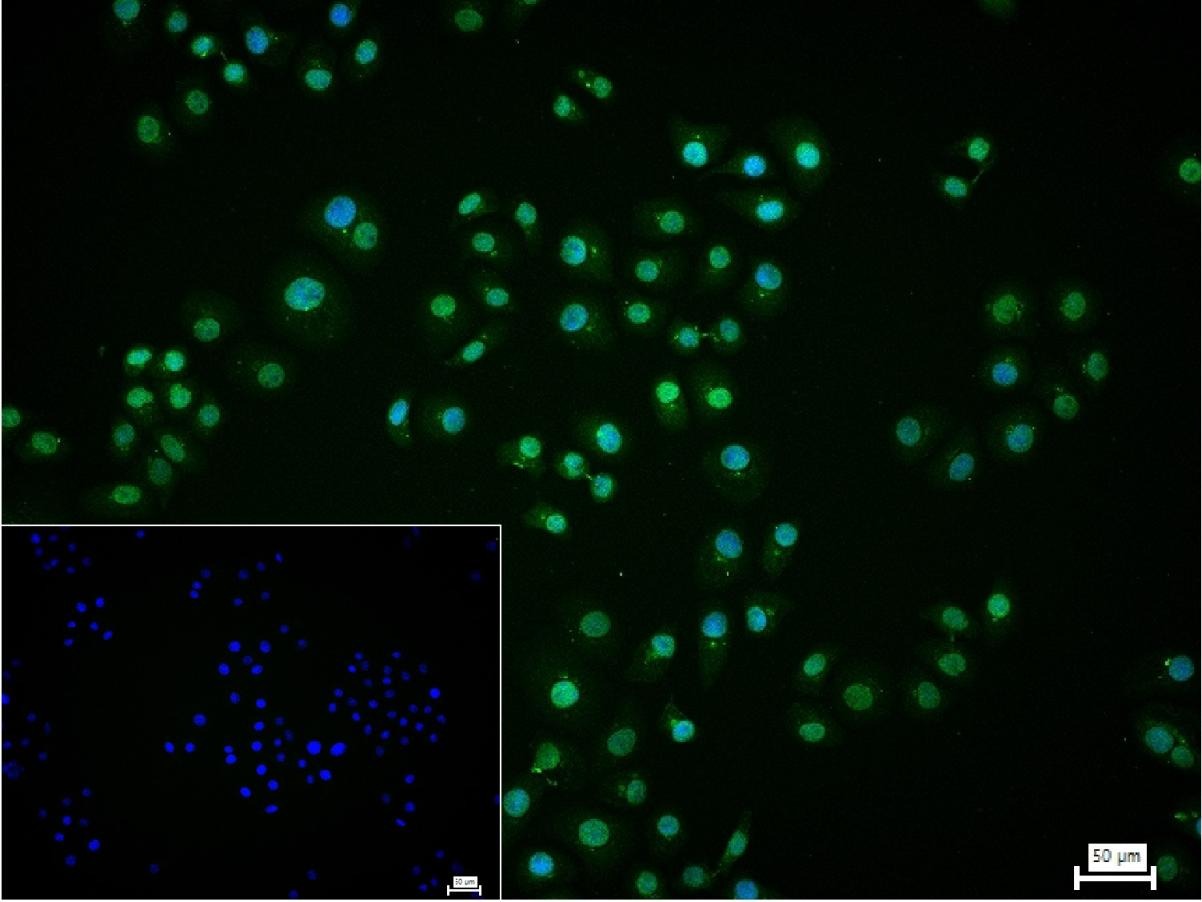Shopping Cart
Remove All Your shopping cart is currently empty
Your shopping cart is currently empty
Anti-HIF-1 alpha Polyclonal Antibody is a Rabbit antibody targeting HIF-1 alpha. Anti-HIF-1 alpha Polyclonal Antibody can be used in FCM,ICC/IF.
| Pack Size | Price | USA Warehouse | Global Warehouse | Quantity |
|---|---|---|---|---|
| 50 μL | $222 | 7-10 days | 7-10 days | |
| 100 μL | $373 | 7-10 days | 7-10 days | |
| 200 μL | $527 | 7-10 days | 7-10 days |
| Description | Anti-HIF-1 alpha Polyclonal Antibody is a Rabbit antibody targeting HIF-1 alpha. Anti-HIF-1 alpha Polyclonal Antibody can be used in FCM,ICC/IF. |
| Synonyms | PASD8, MOP1, hypoxia inducible factor 1, α subunit (basic helix-loop-helix transcription factor), hypoxia inducible factor 1, alpha subunit (basic helix-loop-helix transcription factor), HIF1-α, HIF-1α, HIF1-ALPHA, HIF-1alpha, HIF-1A, HIF-1 α, HIF1, bHLHe78 |
| Ig Type | IgG |
| Reactivity | Human (predicted:Mouse,Rat,Chicken,Pig) |
| Verified Activity | 1. The HepG2 (H) (treated with 500uM CoCl2 for 6 hours) cells were fixed with 4% PFA (10 min at room temperature) and then permeabilized with 90% ice-cold methanol for 20 min at-20°C,the cells then were incubated in 5% BSA to block non-specific protein-protein interactions (30 min at room temperature). Primary Antibody (green): Rabbit Anti-HIF-1 Alpha antibody (TMAB-00855): 1 μg/10^6 cells; Secondary Antibody (white blue): Goat anti-Rabbit IgG-FITC: 1 μg/test. Isotype Control (orange): Rabbit IgG. Blank control (black): PBS. 2. 4% Paraformaldehyde-fixed HepG2 (treated with 500uM CoCl2 for 6 hours)(H) cell; Triton X-100 at RT for 20 min; Antibody incubation with (HIF-1 Alpha) polyclonal Antibody, unconjugated (TMAB-00855) 1:100, 90 min at 37°C; followed by conjugated Goat Anti-Rabbit IgG antibody (green) at 37°C for 90 min, DAPI (blue) was used to stain the cell nucleus. PBS instead of the primary antibody was used as the blank control.   |
| Application | |
| Recommended Dose | ICC/IF: 1:50-200; FCM: 1μg/Test |
| Antibody Type | Polyclonal |
| Host Species | Rabbit |
| Subcellular Localization | Cytoplasm. Nucleus. |
| Tissue Specificity | Expressed in most tissues with highest levels in kidney and heart. Overexpressed in the majority of common human cancers and their metastases, due to the presence of intratumoral hypoxia and as a result of mutations in genes encoding oncoproteins and tumo |
| Construction | Polyclonal Antibody |
| Purification | Protein A purified |
| Appearance | Liquid |
| Formulation | 0.01M TBS (pH7.4) with 1% BSA, 0.02% Proclin300 and 50% Glycerol. |
| Concentration | 1 mg/mL |
| Research Background | Hypoxia inducible factor alpha not only plays a particularly important role in maintaining normal physiological functions of the body under hypoxic conditions, but also plays a crucial role in pathological processes such as tumor growth and neuronal apoptosis HIF1 alpha can regulate the expression levels of many downstream genes Mammalian cells exhibit HIF under low oxygen pressure conditions. HIF is a transcription factor that stabilizes cellular hypoxia. |
| Immunogen | KLH conjugated synthetic peptide: middle of human HIF-1 Alpha |
| Antigen Species | Human |
| Gene Name | HIF1A |
| Gene ID | |
| Protein Name | Hypoxia-inducible factor 1-alpha |
| Uniprot ID | |
| Biology Area | HIF,Hydroxylases,HIF,Jumonji containing proteins,Methylation |
| Function | Functions as a master transcriptional regulator of theadaptive response to hypoxia. Under hypoxic conditions activatesthe transcription of over 40 genes, including, erythropoietin,glucose transporters, glycolytic enzymes, vascular endothelialgrowth factor, and other genes whose protein products increaseoxygen delivery or facilitate metabolic adaptation to hypoxia.Plays an essential role in embryonic vascularization, tumorangiogenesis and pathophysiology of ischemic disease. Binds to coreDNA sequence 5'-[AG]CGTG-3' within the hypoxia response element(HRE) of target gene promoters. Activation requires recruitment oftranscriptional coactivators such as CREBPB and EP300. Activity isenhanced by interaction with both, NCOA1 or NCOA2. Interaction withredox regulatory protein APEX seems to activate CTAD andpotentiates activation by NCOA1 and CREBBP. |
| Molecular Weight | Theoretical: 92 kDa. |
| Stability & Storage | Store at -20°C or -80°C for 12 months. Avoid repeated freeze-thaw cycles. |
| Transport | Shipping with blue ice. |
| Size | Quantity | Unit Price | Amount | Operation |
|---|

Copyright © 2015-2025 TargetMol Chemicals Inc. All Rights Reserved.